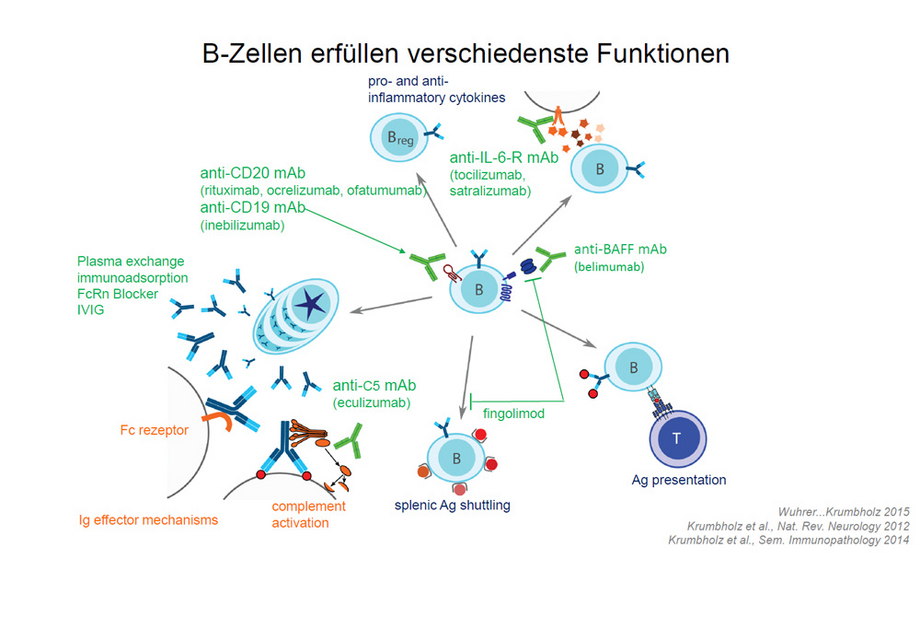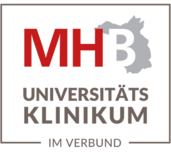Working Group Neuroimmunological diseases
In the working group Neuroimmunologic Diseases, the research focus is B-cell immunology and the pathogenesis of inflammatory CNS diseases such as multiple sclerosis and NMOSD.
Team
- Dr. med. Markus Krumbholz (Head)
- Dr. med. Thomas Brosch
- Michael Hauke
- Julia Weyda
- study nurses: Franka Berger, Sr. Katja, Sr. Jana, Sr. Ramona
Research
We focus on B cell immunology and the pathogenesis of inflammatory CNS diseases such as multiple sclerosis and NMOSD.
B cells constitute an integral part of the immune system in health and disease. In people with multiple sclerosis, B cells contribute significantly to pathogenesis, diagnostic features such as the famous oligoclonal bands, and are target for some of the most effective disease-modifying therapies currently available, like B cell depletion, but are also targeted by a4 integrin blockers, S1P receptor modulator and others. Of note, B cell functions extend far beyond production of immunoglobulins.
While in a classical model of autoimmunity the immune system is the effector and the target organ is passively attacked by the immune system, we nowadays observe that the CNS actively takes part in the inflammatory process. For example, we demonstrated that the TNF superfamily member TNFSF13b (BAFF) is produced even in healthy brain parenchyma and upregulated to the level of secondary lymphatic organs in MS lesions. BAFF is a key cytokine for survival and differentiation of classical B cells, and controls the size of the B cell pool. In the case of MS lesions, especially astrocytes can produce great amounts of BAFF. Upon inflammatory stimulation, the amount of BAFF produced per astrocyte can even exceeded that per macrophage. Thereby astrocytes contribute to a B cell fostering environment in MS.
Selected Publications
- Krumbholz M, Theil D, Derfuss T, Rosenwald A, Schrader F, Monoranu C-M, Kalled SL, Hess DM, Serafini B, Aloisi F, Wekerle H, Hohlfeld R, Meinl E: BAFF is produced by astrocytes and up-regulated in multiple sclerosis lesions and primary central nervous system lymphoma. J. Exp. Med. 2005, 201:195–200. PubMed Volltext (frei zugänglich)
- Krumbholz M, Meinl I, Kümpfel T, Hohlfeld R, Meinl E: Natalizumab disproportionately increases circulating pre-B and B cells in multiple sclerosis. Neurology 2008, 71:1350–1354.
- Hoffmann FS, Hofereiter J, Rübsamen H, Melms J, Schwarz S, Faber H, Weber P, Pütz B, Loleit V, Weber F, Hohlfeld R, Meinl E, Krumbholz M: Fingolimod induces neuroprotective factors in human astrocytes. J. Neuroinflammation 2015, 12:184. PubMed Volltext (frei zugänglich)
- Schuh E, Berer K, Mulazzani M, Feil K, Meinl I, Lahm H, Krane M, Lange R, Pfannes K, Subklewe M, Gürkov R, Bradl M, Hohlfeld R, Kümpfel T, Meinl E*, Krumbholz M*: Features of Human CD3+CD20+ T Cells. J. Immunol. 2016, 197:1111–1117. PubMed Volltext (frei zugänglich)
- Stellmann JP, Krumbholz M, Friede T, Gahlen A, Borisow N, Fischer K et al. Immunotherapies in neuromyelitis optica spectrum disorder: efficacy and predictors of response. JNNP 2017, 88:639-647.
- Kessenbrock K, Krumbholz M, Schönermarck U, Back W, Gross WL, Werb Z, Gröne H-J, Brinkmann V, Jenne DE: Netting neutrophils in autoimmune small-vessel vasculitis. Nat. Med. 2009, 15:623–625. PubMed Volltext (frei zugänglich)
- Pellkofer HL, Krumbholz M, Berthele A, Hemmer B, Gerdes LA, Havla J, Bittner R, Canis M, Meinl E, Hohlfeld R, Kuempfel T: Long-term follow-up of patients with neuromyelitis optica after repeated therapy with rituximab. Neurology 2011, 76:1310–1315.
- Colombo E, Cordiglieri C, Melli G, Newcombe J, Krumbholz M, Parada LF, Medico E, Hohlfeld R, Meinl E, Farina C: Stimulation of the neurotrophin receptor TrkB on astrocytes drives nitric oxide production and neurodegeneration. J. Exp. Med. 2012, 209:521–535.
- Laurent SA, Hoffmann FS, Kuhn P-H, Cheng Q, Chu Y, Schmidt-Supprian M, Hauck SM, Schuh E, Krumbholz M, Rübsamen H, Wanngren J, Khademi M, Olsson T, Alexander T, Hiepe F, Pfister H-W, et al.: γ-secretase directly sheds the survival receptor BCMA from plasma cells. Nat. Commun. 2015, 6:7333.
- Kleiter I, Gahlen A, Borisow N, Fischer K, Wernecke K-D, Wegner B, Hellwig K, Pache F, Ruprecht K, Havla J, Krumbholz M, Kümpfel T, Aktas O, Hartung H-P, Ringelstein M, Geis C, et al.: Neuromyelitis optica: Evaluation of 871 attacks and 1,153 treatment courses. Ann. Neurol. 2016, 79:206–216.

